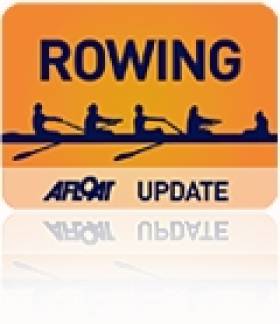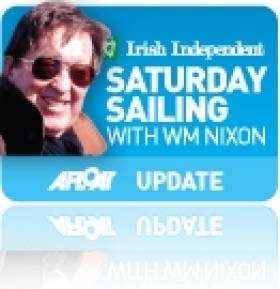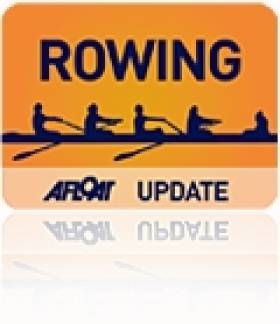Displaying items by tag: NUIG
Dublin and Galway Rowers Take Spoils on Shannon
# ROWING: Galway and Dublin crews dominated the rankings at the Carrick-on-Shannon Head of the River yesterday. Trinity’s senior eight won the second head in 11 minutes 45.3 seconds, and their senior quadruple held off NUIG’s senior four for second.
| 101 | Dublin University BC | mens Senior 8+ | 25:47.2 | 37:32.4 | 11:45.3 | |
|---|---|---|---|---|---|---|
| 102 | Dublin University BC | mens senior 4X- | 26:15.4 | 38:47.0 | 12:31.6 | |
| 103 | NUI Galway BC | mens senior 4- | 26:38.9 | 39:12.2 | 12:33.3 | |
| 105 | Colaiste Iognaid RC | mens J18A 8+ | 27:34.6 | 40:20.9 | 12:46.3 | |
| 111 | Dublin University BC B | mens novice 8+ | 30:08.2 | 42:57.3 | 12:49.1 | |
| 108 | Dublin University BC | mens novice 8+ | 28:52.8 | 41:46.8 | 12:54.0 | |
| 112 | NUI Galway BC | mens intermediate 4+ | 30:41.1 | 43:51.8 | 13:10.6 | |
| 114 | NUI Galway BC B | mens intermediate 4+ | 31:34.4 | 44:49.4 | 13:15.0 | |
| 104 | St. Josephs College RC | mens J18A 8+ | 26:04.2 | 39:22.3 | 13:18.1 | |
| 107 | Commercial RC | mens J18A 4X- | 28:24.4 | 41:47.0 | 13:22.6 | |
| 113 | Dublin University BC | mens intermediate 4+ | 31:09.6 | 44:37.7 | 13:28.1 | |
| 120 | NUI Galway BC | womens intermediate 8+ | 35:46.5 | 49:41.3 | 13:54.8 | |
| 106 | Colaiste Iognaid RC | mens J18A 4X- | 28:06.2 | 42:06.7 | 14:00.6 | |
| 132 | Commercial RC C | mens masters 4+ | 36:47.5 | 51:03.0 | time only | 14:15.5 |
| 119 | Commercial RC | womens intermediate 8+ | 35:10.0 | 49:27.6 | 14:17.6 | |
| 130 | Carrick-on-Shannon RC | mens novice 4X+ | 41:58.8 | 56:28.6 | 14:29.8 | |
| 129 | Dublin University BC | mens novice 4X+ | 41:43.9 | 56:24.4 | 14:40.6 | |
| 117 | Commercial RC B | mens intermediate 2X | 33:42.5 | 48:43.0 | 15:00.4 | |
| 137 | Athlone BC B (Munnelly) | mens J18A 1X | 44:26.7 | 59:30.8 | 15:04.1 | |
| 42 | NUI Galway BC (Egan) | mens intermediate 1X | 37:15.3 | 52:19.6 | time only | 15:04.2 |
| 116 | Commercial RC | mens intermediate 2X | 33:17.4 | 48:23.3 | 15:05.9 | |
| 110 | St. Josephs College RC | mens novice 8+ | 29:37.8 | 44:55.3 | 15:17.5 | |
| 138 | Carrick-on-Shannon RC (Griffin) | mens novice 1X | 45:00.6 | 00:18.6 | 15:18.0 | |
| 136 | Commercial RC (Yeomans) | mens J18A 1X | 43:53.4 | 59:12.5 | 15:19.1 | |
| 148 | Commercial RC | mens J16 2X | 48:59.6 | 04:31.1 | 15:31.5 | |
| 149 | Carrick-on-Shannon RC | mens J16 2X | 49:24.1 | 04:57.2 | 15:33.1 | |
| 133 | Commercial RC B (Gleeson) | mens senior 1X | 42:43.5 | 58:19.4 | 15:35.9 | |
| 131 | Sligo RC | mens novice 4X+ | 42:28.4 | 58:05.7 | 15:37.3 | |
| 123 | Athlone BC | mens J15 8+ | 37:41.5 | 53:23.7 | 15:42.2 | |
| 126 | Carrick-on-Shannon RC | womens J18A 2X | 39:47.0 | 55:32.9 | 15:45.9 | |
| 125 | Commercial RC | womens J18A 2X | 39:29.0 | 55:15.4 | 15:46.4 | |
| 115 | St. Josephs College RC | mens J18 2X | 32:28.5 | 48:17.6 | time only | 15:49.1 |
| 151 | Sligo RC | mens Novice 1X | 50:31.9 | 06:25.7 | 15:53.7 | |
| 134 | Athlone BC A (Egan) | mens J18A 1X | 43:11.9 | 59:22.0 | 16:10.1 | |
| 154 | NUI Galway BC A (Hurst) | womens intermediate 1X | 52:23.9 | 08:36.3 | 16:12.4 | |
| 150 | Colaiste Iognaid RC | mens J16 2X | 50:06.1 | 06:24.1 | 16:18.1 | |
| 169 | Commercial RC B (Baskerville) | mens J15 1X | 59:53.8 | 16:16.5 | 16:22.7 | |
| 155 | Commercial RC A (Foley) | womens intermediate 1X | 52:56.2 | 09:21.8 | 16:25.6 | |
| 147 | City of Derry (Durso) (e) | mens masters 1X | 48:28.5 | 04:55.0 | 14:47.5 | 16:26.5 |
| 143 | Colaiste Iognaid RC | womens J16 4X+ | 46:47.1 | 03:17.8 | 16:30.7 | |
| 167 | Commercial RC A (Beggan) | mens J15 1X | 59:26.1 | 16:02.0 | 16:35.8 | |
| 146 | Belfast BC (Lockwood) (f 61) | mens masters 1X | 47:57.0 | 04:37.1 | 14:25.0 | 16:40.0 |
| 144 | Sligo RC | womens J16 4X+ | 47:18.0 | 04:01.8 | 16:43.8 | |
| 174 | Commercial RC (Rooney) | womens J16 1X | 02:12.8 | 19:01.0 | 16:48.2 | |
| 71 | Commercial RC C (Keogh) | mens J161X | 00:37.7 | 17:26.1 | time only | 16:48.4 |
| 157 | NUI Galway BC B (Keogh) | womens intermediate 1X | 53:26.3 | 10:14.7 | 16:48.4 | |
| 142 | Carrick-on-Shannon RC | womens J16 4X+ | 46:09.9 | 03:01.1 | 16:51.2 | |
| 164 | Garda Siochana BC B | womens novice 4+ | 56:48.7 | 13:40.6 | 16:51.9 | |
| 173 | Commercial RC E (Phelan) | mens J15 1X | 01:38.0 | 18:40.9 | 17:02.9 | |
| 162 | Commercial RC | womens novice 4+ | 56:09.8 | 13:12.9 | 17:03.1 | |
| 160 | Athlone BC | womens J15 4X+ | 54:42.2 | 11:46.4 | 17:04.2 | |
| 121 | Lady Victoria BC (e 234) | mens masters 4+ | 36:24.5 | 53:42.7 | 15:59.2 | 17:18.2 |
| 170 | Commercial RC C (Beggan) | mens J15 1X | 00:00.9 | 17:36.0 | 17:35.1 | |
| 176 | Athlone BC | womens J14 4X+ | 03:01.5 | 20:44.6 | 17:43.1 | |
| 127 | Colaiste Iognaid RC | womens J18A 2X | 40:28.1 | 58:28.7 | 18:00.6 | |
| 152 | Commercial RC | womens J18A 2- | 51:15.0 | 09:28.3 | 18:13.3 | |
| 118 | Dublin University BC | mens intermediate 2X | 34:17.3 | 52:33.6 | 18:16.4 | |
| 153 | Commercial RC B | womens J18A 2- | 51:48.0 | 10:13.6 | 18:25.6 | |
| 172 | Commercial RC D (Byrne) | mens J15 1X | 01:11.9 | 19:46.5 | 18:34.6 | |
| 141 | Sligo RC (Patterson) | mens j16 2X | 45:53.9 | 04:30.4 | 18:36.5 | |
| 166 | NUI Galway BC B | womens novice 4+ | 58:53.5 | 17:47.1 | 18:53.6 | |
| 124 | St. Josephs College RC | mens J15 8+ | 39:02.4 | 57:57.2 | 18:54.8 | |
| 158 | Belfast BC (Lockwood) | womens intermediate 1X | 53:57.4 | 13:02.7 | 19:05.3 | |
| 161 | Sligo RC | womens J15 4X+ | 55:26.6 | 14:33.6 | 19:07.0 | |
| 128 | Commercial RC B | womens J18A 2X | 40:54.2 | 00:34.8 | 19:40.6 | |
| 165 | NUI Galway BC | womens novice 4+ | 58:01.0 | 19:16.8 | 21:15.9 | |
| 175 | Commercial (Rooney | womens J16 1X | 02:37.9 | 25:06.0 | 22:28.2 |
Sailing Needs Students
#icra – Like all consumer sports, sailing has taken something of a battering during the years of recession. The hard core dedicated enthusiasts are still actively involved, for nothing will deflect the true old salt from his or her destiny in and around boats. But many of those who took up sailing as just one of several lifestyle choices in the affluent times have faded away.
It's an ill wind that blows nobody any good. For anyone thinking of returning to sailing, or maybe getting involved for the first time, there's no better time than the present. The infrastructure is there to facilitate manageable expansion, and the people running the sport are keen to recruit newcomers, and bring back those who have strayed.
One area which is proving to be a happy hunting ground is university sailing. That said, it could equally be argued that it is the prodigious pace being set by the college matelots which is prodding the rest of the sailing community into positive action. Call it as you like, but the fact that the Galway University offshore racing boat was hailed as the latest ICRA Boat of the Year at the annual offshore racing conference last weekend struck us as being a very timely move.
We say that despite last week's column being prepared to wager a portion of the housekeeping on another boat altogether. We'll spare their blushes by not naming them, but up against the Galway juggernaut, all opposition fell astern. Team leader Cathal Clarke and his squad from the City of the Tribes put in a fantastic year with Martin Breen's Reflex 38, and as the entire crew were either students or recent graduates from NUIG, they provide the perfect personnel profile to make a healthy and useful longterm input into sailing.
Newly-elected ICRA Commodore Norbert Reilly of Howth is in no doubt that Irish sailing numbers have scope for expansion, and the 2013 programme will certainly keep those involved mighty busy. From early June until mid-July, you could be sailing with an offshore orientation almost continually, with the Dun Laoghaire to Dingle Race on 8th June, then on from Dingle to the ICRA Nationals round the corner in Tralee Bay from June 13th to 15th, then it's back to the south coast for the Sovereigns Cup at Kinsale from 26th to 29th June, followed by a return to the east coast with the Volvo Dun Laoghaire regatta from 11th to 14th July.
The scope which this programme provides for introducing new crews to the sport is enormous, and it will certainly sort out the faint-hearted. The real hard chaws meanwhile will barely be up to speed by mid-July - like the Galway college offshore racing team, they'll be thinking in terms of the Fastnet Race in August.
And for anyone who complains that this is an awful lot of sailing, the answer is usually a brusque comment that, once your time comes, you'll not be sailing for a very long time indeed. Thus our thoughts this weekend are with Cork sailor Kieran Walsh. He's working in Dubai, but this week has been sailing as crew aboard Doug Worrall's First 36.7 Shahrazad in the annual Dubai to Muscat race, a three day RORC event.
You need to do such things to offset the rigours of working in the desert. But they did rather better than that. They won. It's a tough old life, but somebody has to do it.
THE GAFFER OF THE GAFFERS
Tim Magennis, newly-elected President of the Dublin Bay Old Gaffers Association, was in fine form on Tuesday night as he welcomed an eclectic and enthusiastic audience to Sean Cullen's presentation about INFOMAR in Poolbeg Y&BC under the auspices of the Old Gaffers. INFOMAR is the twenty year programme - currently in its twelfth year – to survey the seabed around Ireland and the adjacent ocean in unprecedented detail, and Sean Cullen has proven such a dab hand in charge of the survey ship that he is consulted by other nations keen to get in on the acquisition of knowledge of the deep.
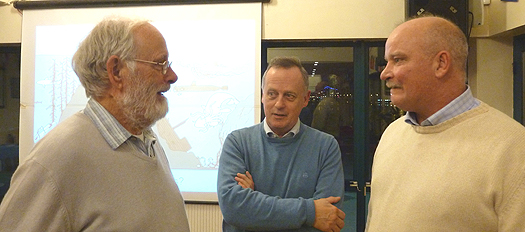
The Boyd men of Poolbeg. Owners of Herbert Boyd-designed classics at the OGA gathering in Poolbeg Y&BC are (left to right) Tim Magennis (Marguerite, 1894), Ian Malcolm (Aura, 1898) and Sean Cullen (Eithne, 1893). Photo: W M Nixon
As for Tim Magennis, it made for a high profile week, as he had something of a starring role on Thursday night in TG4's extensive filmed documentary about Erskine Childers. Most appropriately, the guru of the gaffers was involved on the television programme to explain the skills involved in sailing the engineless Asgard to Howth with the cargo of guns in July 1914, and especially to highlight the sheer brilliance with which Molly Childers helmed Asgard to bring her gently alongside the pier, neatly head to wind in a strong nor'wester, a formidable display of seamanship.
Sean Cullen's work in surveying the seas of Ireland and their hidden depths is fascinating. And it's a bit scary to discover just how much is still to be discovered, when we tend to assume every major hazard has been known about and on the charts for decades. The most striking example of this is a previously unknown pinnacle rock a few miles westward of Slyne Head. There's 12 metres over it, which explains why it has gone undetected for so long. But as the rock is a bit like St Patrick's Cathedral plonked down in the middle of an otherwise fairly flat bit of the seabed, until it was discovered it represented a potential danger for any supertankers which happened to be proceeding up the west coast of Ireland.
OLD BOATS ON A COLD COLD SEA
The gaff enthusiasts of Dublin Bay are gearing themselves up to welcome fellow gaffers at the June Bank Holiday weekend next year, as Dublin Bay will be an important focal point in the Irish Sea for the rolling cruise-in-company with which the many branches of the OGA will be celebrating its Golden Jubilee.
Of course, for some folk in Ireland, making a song and dance about preserving gaff rig seems decidedly weird. It's not that this select group have rejected gaff rig entirely. On the contrary, as far as the Howth 17s are concerned, it never went away. They still sail their boats rigged exactly as they were designed in 1898 by Herbert Boyd, and they see little reason to change.
The OGA gathering in Poolbeg provided a rare opportunity for the owner-skippers of three different Herbert Boyd-designed gaff classics to get together. Sean Cullen owns the 25ft Eithne, the first Boyd yacht, built by Boyd himself in the boathouse at Howth House in 1893. Tim Magennis owns the 24ft Marguerite (that was Marguerite in the early part of the Childers film), which was built by Jack Wellington, a sailor/boatbuilder from Scandinavia who somehow acquired the name Wellington when he settled in Malahide. And Ian Malcolm owns the Howth 17 Aura, one of the original batch of five Howth 17s which were built by John Hilditch of Carrickfergus in 1898, and sailed home to Howth by their owners.
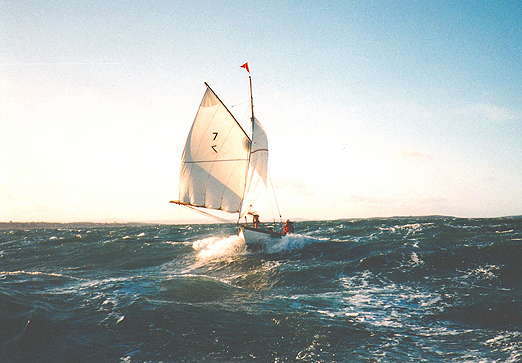
Baby, it's cold outside.... Ian Malcolm's Howth 17 Aura sailing from Carrickfergus to Howth on the evening of April 15th 1998 to celebrate the Centenary of the first five boats of the class making the same delivery passage in April 1898. The land just visible is the County Down coast on the left, the Antrim coast in the distance, and Copeland Island on the right. Photo: Damien Cronin
That inaugural voyage of the Howth 17s was replicated for the Class's Centenary in April 1998 in a strong and very cold nor'easterly wind. At least it was a fair wind, but conditions were otherwise Arctic. As one of those who took part, Ian Malcolm, was uniquely qualified on Tuesday night to tell the OGA enthusiasts about what is involved in sailing vintage gaff rigged yachts from Belfast Lough to Dublin Bay, which will be part of the Golden Jubilee programme.
But at least they'll be doing it in June rather than April, and they'll be doing it in boats with lids rather than a Howth 17, which passes the Number One test for a genuine classic – they're diabolically uncomfortable boats to crew aboard, even in pleasant conditions. In April 1998 with temperatures plunging towards freezing point during the overnight 85 mile sail, they were torture chambers, but the crews didn't notice - they were completely numb with cold......
NUIG/Grainne Mhaol will have just one change of personnel to the crew which won the men’s senior eights as NUIG last year at this year's National Rowing Championships. Liam Molloy comes in for Paul Giblin, who is work-tied. UCD have a strong crew, which will be stroked by Tom Doyle, while Queen’s University have just three members of last year’s crew. Trinity will be represented by their intermediate eight. The Championships start on Thursday at the National Rowing Centre in Farran Wood, Cork. The first big final is the women’s senior four, which is scheduled for 12 o’clock.
Cork Institute of Technology Win 2010 Student Yachting Nationals
Last weekend saw the Student Yachting Nationals take place at the Royal Cork Yacht Club. The students had the use of the ISA J80 Sailfleet for the event. Six college teams entered for the Nationals which was the Qualifier for the Student Yachting World Cup 2011.
Racing was scheduled for Cuskinny on Friday and conditions were ideal with 17-20 knots of breeze. Race Officer, Nathan Kirwan, got in four good races lasting some 40 to 50 minutes each. However, spinnakers were banned as some wipeouts had been observed by the ISA Bosun who exercised his judgment in this regard. Some two minutes after the start of the first race UCC skippered by Robert O'Leary suffered a snapped halyard but were refused redress. CIT skippered by George Kenefick lost their only winch handle overboard some three minutes before the start in race 1 but still managed to win the race by a comfortable margin. In race 2 UCC came back strongly to take the gun and pushing CIT into second place. At this stage match racing had begun between the two Cork colleges with each throwing dummy tacks to try to clear their air. In Race 3 TCD skippered by Alistair Kissane took the win with CIT in second and UCC third. The final race of the day was won by CIT with UCC third. Overall standings for Day One were: CIT 6pts, with UCC and TCD on 12 pts each. UCD had got off to a shaky start which was to prove costly for them as they were on form on days two and three.
On day two the Race Officer moved the course to the Curlane Bank and spinnakers were permitted. CIT found their rythym taking the bullet in race 5 with UCD in second and a poor mark rounding relegated UCC to third place. Race 6 saw the O'Leary and Kenefick teams doing circles at the pre start as the competition was intensifying and it was looking like a two horse race. UCC took first place with NUIG taking second and CIT third. Donagh Good of CIT went for a quick dip in the cold water but managed to grab on and was pulled back on board by George Kenefick and Kevin Goulding. Later during day 2 the wind was rising to 22 knots so spinnakers were once again banned. UCC found the conditions very much to their liking, taking the win, with TCD in second, UCC third and CIT fourth. Race 8 proved to be rather interesting with CIT managing to relegate UCC to last position and managing to keep UCC in their sight for the duration of the race. Downwind was difficult for CIT with UCC right on their tail but UCC were not successful in finding a passing lane. Again, UCD took their second bullet of the day with CIT and UCC in fifth and sixth positions some four to five minutes behind the rest of the fleet. CIT were able to discard their fifth position but UCC were unlucky in having to count their sixth as they also had a sixth from day one. TCD again got a second position. Results after day two were: CIT 14pts, UCC 19pts, UCD and TCD on 21pts each.
Day 3 was a non discardable coastal race from Crosshaven to Kinsale counting for 1.5pts. The start line was just off Roches Point with five knots of breeze and brilliant sunshine. UCC led the fleet and NUIG and CIT were in last position 300 metres behind the rest of the fleet. As the race went on the wind increased to a nice south westerly breeze of 12 to 14 knots. As this stage it looked as if it might be UCC's lucky day but Team CIT maintained their composure and by tacking close to the shore and keeping out of the tide managed to finish in third position at the Bulman Buoy with UCC first and UCD second. This result was to prove sufficient to give CIT the national student title for 2010.
Overall Results:
CIT 18.5pts
UCC 20.5pts
UCD 24pts
TCD 28.4pts
NUIG 33pts
UL 40pts


























